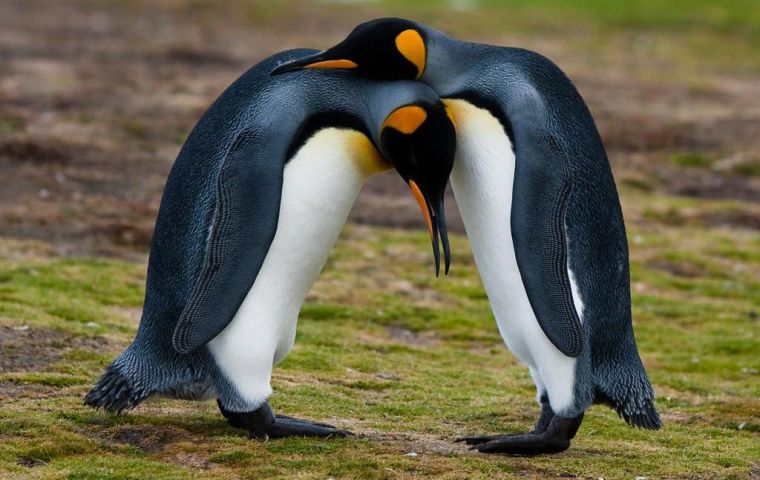MercoPress. South Atlantic News Agency
Meet the Falkland Islands penguins
 King Penguins at Volunteer Point - Falkland Islands (Pic D.Pettersson)
King Penguins at Volunteer Point - Falkland Islands (Pic D.Pettersson) By Chloe May - On 25 April every year, people around the world celebrate World Penguin Day - a day to raise awareness of the plight these flightless birds are currently facing. This takes place at the same time as the annual northern migration of Antarctica’s Adelie penguins and was created as a way for researchers at an American research centre on Ross Island to pass time and raise awareness.
Military activity has been banned on Antarctica since 1961, however did you know that you don't have to travel to the southern polar region to see penguins in the wild? Especially if you are sent to the Falklands, which is where five species of these waddling birds call home.
King penguins are one of the most famous species of penguin in the world. Almost five decades ago, there were only 31 breeding pairs living on East Falkland island. It has since gone on to become the second-largest accessible King penguin colony in the world, with over 1,500 pairs now breeding there.
More than 121,000 pairs of Gentoo penguins were recorded at the Falklands during the last census in 2010, making this group the world’s largest population of Gentoo penguins. Standing 76cm tall, this species can be found on the islands all year round, and they're easily recognizable due to the white markings on the tops of their heads.
The Southern Rockhopper is the smallest species of penguin found in the Falklands. These spiky-haired creatures do just as their name says - hop around on the rocky cliff-tops of Bleaker Island. With 320,000 pairs returning to the islands to breed every October, it would be difficult not to spot them.
One of the more lesser known species is the Magellanic penguin. They were named after the Portuguese explorer, Ferdinand Magellan, and live in two metre deep burrows on Pebble Island. They have the ability to dive to depths of up to 90 metres in order to catch their prey, which includes fish and krill.
Macaroni penguins are one of the Falklands' rarest penguins. Not only are there only 24 pairs living on the islands, but they are often found amongst rockhopper colonies - making them even trickier to see! An easy tip to remember is that they have bigger bodies, and bright yellow hair-dos. (Forces Network)
(*) Chloe May is a freelance wildlife and environment writer, with seven years of journalism experience behind her.
She has always had a passion for animals and the planet we share with them, and takes pride in creating informative and engaging content on a host of subjects. From writing about newly discovered species and conservation success stories, to covering the darker subjects affecting our planet - such as animal trafficking and climate change - Chloe has written about it all.
You can read more articles like this at Chloemaywrites.com, and you can discover fun animal facts on her social media accounts:
King Penguins
Gentoo Penguins
Macaroni Penguins
Magellanic Penguins
Rockhopper Penguins




Top Comments
Disclaimer & comment rulesCommenting for this story is now closed.
If you have a Facebook account, become a fan and comment on our Facebook Page!